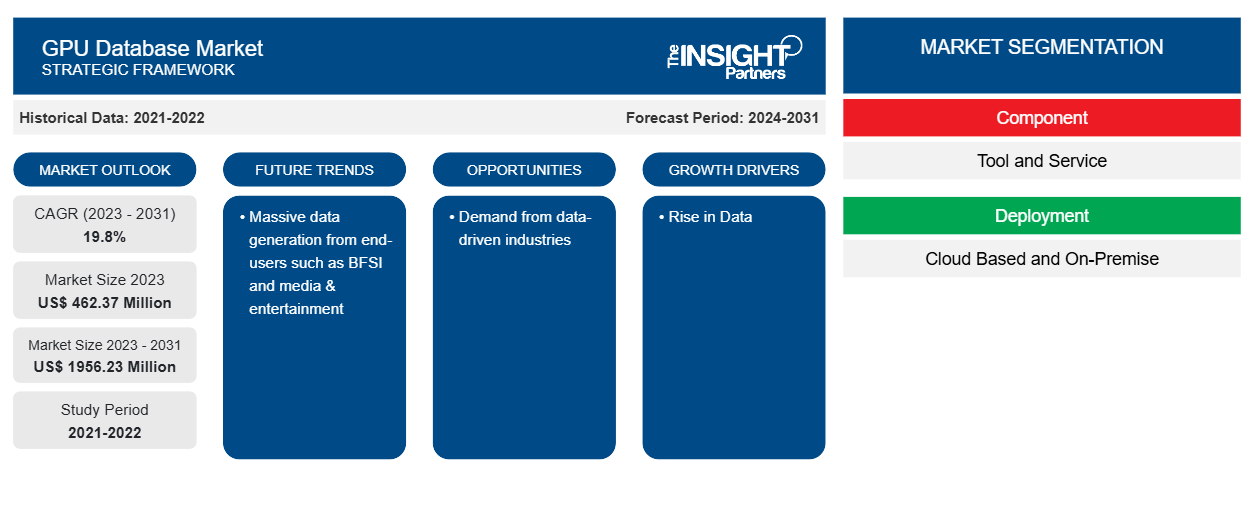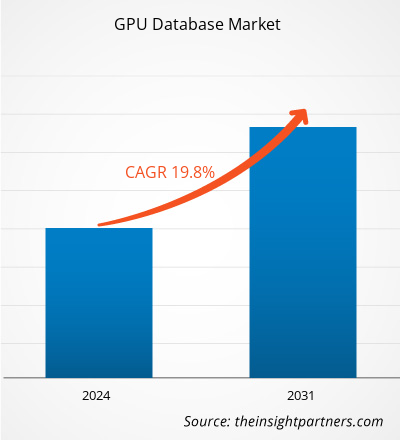The GPU database market size is projected to reach US$ 1956.23 million by 2031 from US$ 462.37 million in 2023. The market is expected to register a CAGR of 19.8% during 2023–2031. The rise in data and the growing data-driven industries are likely to remain key trends in the market.
GPU Database Market Analysis
The growing data-driven industries are one of the major driving factors of the GPU database market. The rise in digitalization and the inclination of companies towards solutions to process large datasets is fuelling the market growth. The GPU database finds its application in some of the emerging technologies such as artificial intelligence, machine and deep learning, Internet of Things (IoT), and geospatial analytics, which creates huge opportunities for GPU database market growth.
GPU Database Market Overview
A GPU database uses graphics processing units (GPUs) to perform database operations. A GPU is a programmable processor designed to quickly render high-resolution images and videos. The GPU database processes huge data volumes quicker and more effectively than CPUs because they operate in parallel instead of in sequence. Thus, GPU databases are typically faster and geared towards analytics, which is more flexible in processing many different types of data or much larger amounts of data.
Customize This Report To Suit Your Requirement
You will get customization on any report - free of charge - including parts of this report, or country-level analysis, Excel Data pack, as well as avail great offers and discounts for start-ups & universities
GPU Database Market: Strategic Insights

-
Get Top Key Market Trends of this report.This FREE sample will include data analysis, ranging from market trends to estimates and forecasts.
GPU Database Market Drivers and Opportunities
Rise in Data to Favor the Market
With the advent of digitalization, the data is generated at a tremendous rate. The data of various varieties, volumes, and velocities needs to be analyzed and processed to carry out any hidden patterns and insights with the help of data analytics techniques. Traditional analytics fails to provide optimum analytics techniques and technologies. This generates the need for a GPU database. With massively parallel processing capabilities, GPU database cost-effectively provides high performance computing. GPU database is an ideal solution to handle large datasets, which drives the demand for this technology.
Demand from data-driven industries.
GPU data has high computation power. Due to their parallel processing capabilities, they can process data up to 100 times faster than configurations containing only CPUs, as illustrated. Thus, various data-driven industries such as BFSI, media & entertainment, and others demand solutions to processing-intensive workloads for data analytics applications, which drives the demand for GPU databases. The market players are launching solutions to cater to this demand. Graphistry launched Hub Pro (Graphistry Hub for Professionals) to bring GPU-accelerated visual graph analysis to customers. Graphistry Hub Pro solves security, pricing, and maintenance for individuals, and the upcoming Hub Organizations for teams. (Source: Graphistry, Press Release, September 2021)
GPU Database Market Report Segmentation Analysis
Key segments that contributed to the derivation of the GPU database market analysis are component, deployment, application, and industry vertical.
- Based on the component, the GPU database market is divided into tool and service. The tool segment held the largest share of the market in 2023.
- By deployment, the market is segmented into cloud based and on-premise. The cloud based is expected to grow with the highest CAGR.
- By application, the market is segmented into fraud detection & prevention, governance risk & compliance (GRC), customer experience management, predictive maintenance, supply chain management, threat intelligence, and others. The customer experience management held a significant share of the market in 2023.
- By industry vertical, the market is segmented into BFSI, IT & telecom, retail & e-commerce, healthcare, transportation & logistics, government & defense, and others. The BFSI held a significant share of the market in 2023.
GPU Database Market Share Analysis by Geography
The geographic scope of the GPU database market report is mainly divided into five regions: North America, Asia Pacific, Europe, Middle East & Africa, and South & Central America.
Asia Pacific region is expected to grow with the highest CAGR. The rise in digitalization and growing demand for advanced data analytics techniques in developing economies such as India and China is driving market growth in the region. Digital transformation across data-driven industries such as BFSI, healthcare, manufacturing, and others, further drives market growth. The increasing demand for extracting insights from large datasets is fuelling the market growth in Asia Pacific.
GPU Database Market Regional Insights
The regional trends and factors influencing the GPU Database Market throughout the forecast period have been thoroughly explained by the analysts at The Insight Partners. This section also discusses GPU Database Market segments and geography across North America, Europe, Asia Pacific, Middle East and Africa, and South and Central America.
GPU Database Market Report Scope
| Report Attribute | Details |
|---|---|
| Market size in 2023 | US$ 462.37 Million |
| Market Size by 2031 | US$ 1956.23 Million |
| Global CAGR (2023 - 2031) | 19.8% |
| Historical Data | 2021-2022 |
| Forecast period | 2024-2031 |
| Segments Covered |
By Component
|
| Regions and Countries Covered |
North America
|
| Market leaders and key company profiles |
|
GPU Database Market Players Density: Understanding Its Impact on Business Dynamics
The GPU Database Market is growing rapidly, driven by increasing end-user demand due to factors such as evolving consumer preferences, technological advancements, and greater awareness of the product's benefits. As demand rises, businesses are expanding their offerings, innovating to meet consumer needs, and capitalizing on emerging trends, which further fuels market growth.

- Get the GPU Database Market top key players overview
GPU Database Market News and Recent Developments
The GPU database market is evaluated by gathering qualitative and quantitative data post primary and secondary research, which includes important corporate publications, association data, and databases. A few of the developments in the GPU database market are listed below:
- NVIDIA and HP Inc. announced the integration of NVIDIA CUDA-X data processing libraries with HP AI workstation solutions to turbocharge the data preparation and processing work that forms the foundation of generative AI development. Built on the NVIDIA CUDA compute platform, CUDA-X libraries speed data processing for a broad range of data types, including tables, text, images and video. They include the NVIDIA RAPIDS cuDF library, which accelerates the work of the nearly 10 million data scientists using pandas software by up to 110x using an NVIDIA RTX 6000 Ada Generation GPU instead of a CPU-only system, without requiring any code changes. (Source: NVIDIA, Press Release, March 2024)
- Zilliz, a trailblazer in vector database technology, announced the release of Milvus 2.4, setting a new standard in vector search capabilities with a groundbreaking GPU indexing feature powered by NVIDIA’s CUDA-Accelerated Graph Index for Vector Retrieval (CAGRA), part of the RAPIDS cuVS library. (Source: Zilliz, Press Release, March 2024)
GPU Database Market Report Coverage and Deliverables
The “GPU Database Market Size and Forecast (2021–2031)” report provides a detailed analysis of the market covering below areas:
- GPU database market size and forecast at global, regional, and country levels for all the key market segments covered under the scope
- GPU database market trends as well as market dynamics such as drivers, restraints, and key opportunities
- Detailed PEST/Porter’s Five Forces and SWOT analysis
- GPU database market analysis covering key market trends, global and regional framework, major players, regulations, and recent market developments
- Industry landscape and competition analysis covering market concentration, heat map analysis, prominent players, and recent developments for the GPU database market
- Detailed company profiles
Frequently Asked Questions
What would be the estimated value of the GPU database market by 2031?
Which are the leading players operating in the GPU database market?
What is the future trend of the GPU database market?
What are the driving factors impacting the GPU database market?
What is the expected CAGR of the GPU database market?
- Historical Analysis (2 Years), Base Year, Forecast (7 Years) with CAGR
- PEST and SWOT Analysis
- Market Size Value / Volume - Global, Regional, Country
- Industry and Competitive Landscape
- Excel Dataset
Recent Reports
Testimonials
Reason to Buy
- Informed Decision-Making
- Understanding Market Dynamics
- Competitive Analysis
- Identifying Emerging Markets
- Customer Insights
- Market Forecasts
- Risk Mitigation
- Boosting Operational Efficiency
- Strategic Planning
- Investment Justification
- Tracking Industry Innovations
- Aligning with Regulatory Trends





















 Get Free Sample For
Get Free Sample For